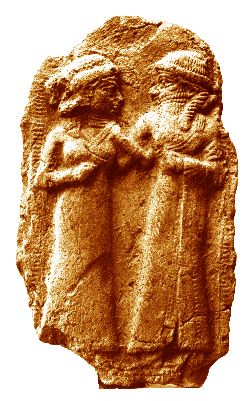In Sumer and later in Babylon, religious rituals involved sacred sexuality in the form of the Sacred Marriage or hieros gamos, an act simulating marriage between the fertility goddess Inanna/Ishtar and the shepherd god, Dumuzi. In this act, the high priestess of Inanna would have intercourse with either the high priest or the king of the city. Through the sexual act, divine fertile energy was released on the land ensuring good crops and productive herds. Sacred prostitution involved temple priestesses of Inanna/Ishtar having ritual sex with male visitors to the temple, again releasing the divine fertile energy. Both of these sacred sexual practices existed for thousands of years in Mesopotamia. It is best to understand these rituals as a religious act of devotion to the goddess rather than as sex per se. After all, secular prostitutes plied their trade in Mesopotamian cities as well.
Sacred Marriage
In the many myths and stories involving Inanna in ancient Mesopotamia, Inanna does not appear as either wife or mother. Yet it is she that makes the Sacred Marriage with her husband Dumuzi in a fertility rite. Remember that in Mesopotamia, agriculture held primary importance and keeping the land fertile required many religious observances. In the Sacred Marriage, humans took the place of the gods in religious rituals devoted to fertility. The high priestess of the city, acting in the capacity of the fertility goddess Inanna, would have sex with the high priest or the king role-playing the fertility god Dumuzi.
In the myths concerning Inanna and Dumuzi, due to some of Inanna’s less exalted behavior, Dumuzi must spend half the year in the underworld. When his time is up and he returns from the underworld in springtime, he joyously mates with Inanna and the land reawakens. Those familiar with the Greek myth of Demeter and Persephone will recognize the precedence found in the earlier Inanna myths.
Sacred Prostitution
Scholars have yet to settle on the question of whether sacred prostitution took place. Herodotus, a Greek historian, wrote that every Babylonian woman had to attend the temple of Ishtar/Inanna and agree to sex with any male that asked her. Once she performed this ritual, the male visitor gave her money to donate to the temple. Scholars have called this sacred prostitution, although the rite was essentially performed as a devotion or prayer to the goddess to ensure fertility. Herodotus, however, is an unreliable reporter, which is why scholars debate the historicity of this practice.
Inanna, who later transformed into the Akkadian goddess Ishtar, the Phoenician Astarte and later still as the Greek goddess Aphrodite, is the goddess of love, sex, beauty and fertility. Priestesses of this goddess, at least one order of them, performed as sacred prostitutes, lying with males who desired their services in ritual sexuality. This order of priestess was called Nin-Gig in Sumeria.
This article is part of our larger resource on Mesopotamian culture, society, economics, and warfare. Click here for our comprehensive article on ancient Mesopotamia.
Cite This Article
"Sacred Marriage and Sacred Prostitution in Ancient Mesopotamia" History on the Net© 2000-2024, Salem Media.
April 24, 2024 <https://www.historyonthenet.com/sacred-marriage-and-sacred-prostitution-in-ancient-mesopotamia>
More Citation Information.

